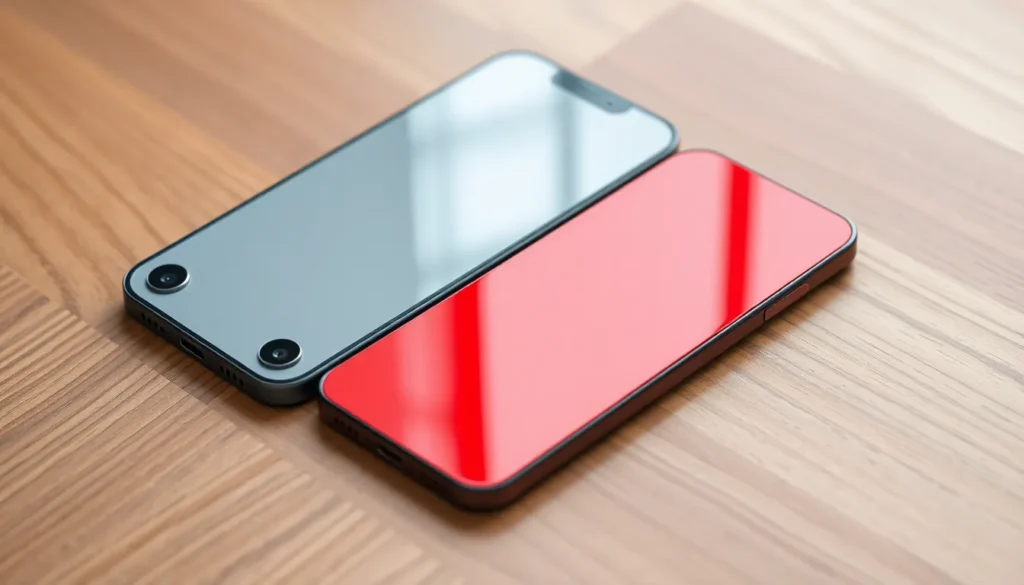Table of Contents
ToggleWhen it comes to smartphones, the battle between the iPhone 11 and iPhone 12 is like a classic showdown between two heavyweight champions. On one side, you’ve got the iPhone 11, a reliable contender that’s been winning hearts with its impressive features and solid performance. On the other side, the iPhone 12 steps into the ring with a sleek design, 5G capabilities, and a camera that could make even a potato look good.
But is the iPhone 12 really worth the upgrade? Or is it just a shiny new toy that’s all bark and no bite? As they dive into this comparison, readers will uncover the key differences that might just tip the scales in favor of one device over the other. Get ready to find out if the iPhone 12 deserves a spot in your pocket or if the trusty iPhone 11 is still the champ.
Design Comparison
The design of the iPhone 11 and iPhone 12 showcases notable differences that influence user preferences. Both devices embody Apple’s aesthetic appeal, yet they present different strengths.
Build Quality and Materials
Apple enhanced the iPhone 12 with a Ceramic Shield front cover, which provides four times better drop performance compared to the iPhone 11. This addition increases durability, making it more resistant to scratches and impacts. The iPhone 12 also features an aluminum frame, offering a premium feel. In contrast, the iPhone 11 uses a glass back, which, while elegant, lacks the same level of resilience. Both models maintain water and dust resistance with an IP68 rating, ensuring they withstand various conditions.
Color Options
Color choices differentiate the iPhone 11 from the iPhone 12 significantly. The iPhone 11 offers six vibrant colors: black, white, green, yellow, purple, and Product(Red). This array appeals to those who favor personalization. In comparison, the iPhone 12 features more subdued hues, including black, white, blue, green, red, and a new purple variant. Each option reflects a modern aesthetic that attracts different user demographics. While the iPhone 11’s colors exude cheerfulness, the iPhone 12 emphasizes sophistication.
Performance Analysis

Performance stands as a crucial factor when comparing the iPhone 12 and iPhone 11. Both devices deliver solid performance, but the differences in their internal components notably influence user experience.
A14 Bionic Chip vs A13 Bionic Chip
Supporting faster processing speeds, the A14 Bionic chip propels the iPhone 12 ahead of the A13 Bionic chip found in the iPhone 11. Featuring a 5-nanometer architecture, the A14 chip enhances efficiency while delivering superior performance for gaming and multitasking. Benchmarks indicate that the A14 outperforms the A13 in computational tasks by as much as 15% to 20%. Users benefit from a smoother experience, especially with demanding applications. Additionally, the improved graphics performance of the A14 allows for more immersive gaming experiences and better visual quality in applications.
RAM and Storage Options
Offering 4GB of RAM, both the iPhone 11 and iPhone 12 provide adequate performance for most tasks. Variations in storage options exist, however, with the iPhone 12 starting at 64GB and going up to 256GB, while the iPhone 11 offers choices from 64GB up to 128GB. Users requiring ample storage for apps and media may find the iPhone 12 more accommodating. In real-world usage, the RAM and storage configurations support smooth operation for everyday activities like browsing and streaming. Those who prioritize high-performance tasks often prefer the added storage capacity of the iPhone 12.
Camera Capabilities
Camera capabilities present a significant factor in the choice between the iPhone 11 and iPhone 12. Each model offers unique enhancements catering to different photography needs.
Rear Camera Improvements
Rear camera improvements significantly enhance the iPhone 12’s appeal. It features a dual-camera setup with a 12MP wide and a 12MP ultra-wide lens, similar to the iPhone 11. However, night mode capabilities see marked improvement, offering better low-light performance. The introduction of Smart HDR 3 on the iPhone 12 optimizes photos for greater detail and color accuracy. Users can capture images with improved contrast and dynamic range compared to the previous model. Additionally, the ability to record HDR video with Dolby Vision on the iPhone 12 provides a new level of video quality, catering to creators and casual users alike.
Front Camera Features
Front camera features also showcase notable advancements in the iPhone 12. Both models include a 12MP front camera, yet the iPhone 12 supports night mode for selfies, significantly enhancing low-light performance. The addition of Smart HDR 3 further improves image quality, ensuring more natural skin tones and better lighting. Video recording capabilities also see an upgrade, allowing 4K recording at 60 frames per second on the iPhone 12. These enhancements make the front camera on the iPhone 12 a better choice for video calls and selfies, appealing especially to social media enthusiasts.
Battery Life
Battery life significantly impacts user experience. Comparing the iPhone 11 and iPhone 12 reveals notable differences in this area.
Battery Capacity Comparison
The iPhone 11 features a battery capacity of 3,110 mAh, while the iPhone 12 has a slightly smaller battery at 2,815 mAh. Even with a smaller capacity, the iPhone 12 benefits from improved energy efficiency due to its A14 chip. Users report similar longevity in real-world usage, with both models typically lasting a full day under moderate conditions. This performance reflects advancements in battery management rather than raw size. For heavy users, both devices facilitate all-day usage, even with demanding applications.
Charging Technologies
Charging technologies also differ between the models. The iPhone 12 supports MagSafe wireless charging up to 15W, enhancing convenience with easy alignment for optimal charging. In contrast, the iPhone 11 supports Qi wireless charging but only at a maximum of 7.5W. Both devices also offer fast charging capabilities through the Lightning connector, allowing for 50% charge in around 30 minutes with a 20W adapter. Users benefit from varied options depending on their charging habits and preferences.
Software Experience
The software experience plays a crucial role in differentiating the iPhone 11 from the iPhone 12. Both devices run on iOS, but the iPhone 12 benefits from more advanced features and updates.
iOS Features and Updates
iOS 14 introduced several new features enhancing user experience. The iPhone 12 showcases features such as Widgets, App Clips, and enhanced privacy settings not available on the iPhone 11’s earlier iOS version. Users enjoy improved customization and enhanced functionality with the latest updates. Regular updates ensure the iPhone 12 remains at the forefront of software advancements, while the iPhone 11 might miss some of the newest features over time. This gives the iPhone 12 a clear advantage in software longevity and user engagement.
User Interface Enhancements
User interface changes mark a significant improvement in the iPhone 12. A redesigned home screen adds flexibility through customizable Widgets, allowing users to navigate better and access information quickly. Apple also refined the Control Center for easier access to settings and a more intuitive user experience. While both devices offer a seamless interface, the enhancements in the iPhone 12 create a more appealing environment for interaction. Differences in responsiveness and speed during navigation contribute to an elevated software experience on the iPhone 12 compared to its predecessor. Users appreciate features focused on accessibility and ease of use, making the iPhone 12 a more desirable option.
Price and Value
Price and value play crucial roles in deciding between the iPhone 11 and iPhone 12.
Initial Pricing Differences
The iPhone 11 starts at approximately $699, while the iPhone 12 has a starting price of around $799. Although the iPhone 12’s higher price reflects its upgraded features, users must consider whether those enhancements justify the cost increase. Discounts often apply to the iPhone 11, making it more attractive for budget-conscious consumers. Furthermore, many retailers offer trade-in programs, allowing for potential savings on the newer iPhone 12. Comparing these prices helps potential buyers weigh their options effectively.
Long-Term Value Proposition
Value extends beyond initial pricing. The iPhone 12’s advanced features and technologies promise longer-term benefits, particularly with software updates. Device longevity often impacts users’ choices, highlighting the importance of future-proofing. Enhanced camera capabilities and 5G support in the iPhone 12 ensure better performance for years to come. Users looking for a device that accommodates evolving needs may find the iPhone 12’s features especially valuable. Investing in a more future-ready device typically reduces the costs associated with upgrading sooner than expected.
Choosing between the iPhone 11 and iPhone 12 ultimately hinges on individual needs and preferences. The iPhone 12 stands out with its modern design enhanced camera features and 5G capabilities, making it a strong contender for those seeking the latest technology. On the other hand the iPhone 11 offers solid performance and reliability at a more budget-friendly price.
For users who value cutting-edge features and longevity the iPhone 12 is likely the better choice. However for those who prioritize cost-effectiveness and still want a capable device the iPhone 11 remains an appealing option. Ultimately it’s about finding the right balance between budget and desired features to suit one’s lifestyle.







